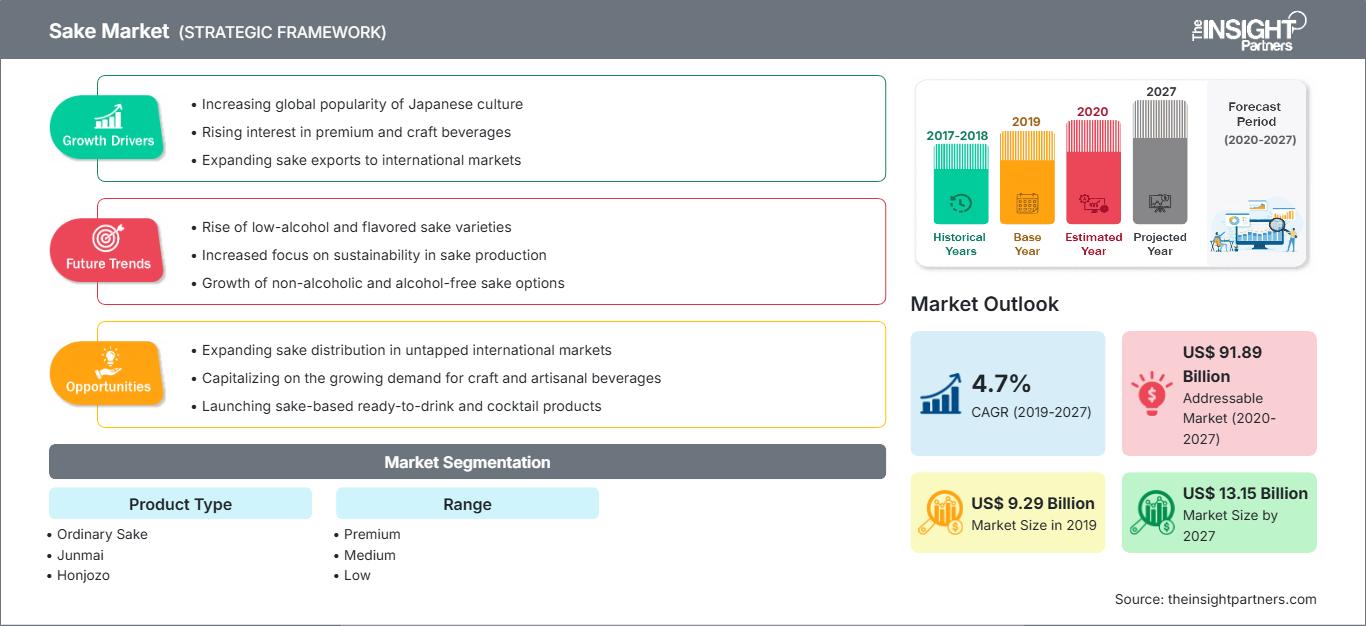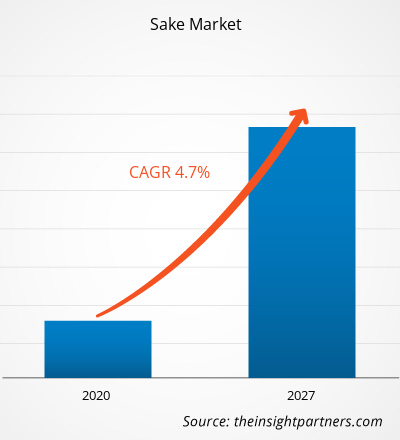Der Sake-Markt wurde 2019 auf 9.290,16 Millionen US-Dollar geschätzt und soll bis 2027 13.146,68 Millionen US-Dollar erreichen; von 2020 bis 2027 wird ein CAGR-Wachstum von 4,7 % erwartet.
Sake ist ein japanisches alkoholisches Getränk, das aus fermentiertem Reis hergestellt und als Reiswein bezeichnet wird. Sake wird im Allgemeinen aus poliertem Sake-Mai-Reis, einem Schimmelpilz namens Aspergillus oryzae, Wasser und Hefe gebraut. Edle Sake-Sorten reifen über ein Jahr lang, und die meisten Varianten haben einen Alkoholgehalt zwischen 15 % und 20 %.
Der Sake-Markt in Nordamerika wird im Prognosezeitraum voraussichtlich das höchste CAGR-Wachstum aufweisen. Das Wachstum des Sake-Marktes in dieser Region ist hauptsächlich auf den steigenden Konsum alkoholischer Getränke in Nordamerika zurückzuführen. Die wachsende Nachfrage nach alkoholischen Getränken, einschließlich Sake, wird durch die steigende Anzahl an Brauereien und Destillerien in der Region gedeckt. Die steigende Nachfrage nach Sake in Nordamerika hat Hersteller dazu bewogen, sich in der Region niederzulassen, was das Wachstum des nordamerikanischen Sake-Marktes weiter vorangetrieben hat. Etablierte Unternehmen wie Takara Sake USA Inc., Gekkeikan Sake und Ozeki Sake bieten Wachstumschancen für den nordamerikanischen Sake-Markt.
Sie erhalten kostenlos Anpassungen an jedem Bericht, einschließlich Teilen dieses Berichts oder einer Analyse auf Länderebene, eines Excel-Datenpakets sowie tolle Angebote und Rabatte für Start-ups und Universitäten.
Sake-Markt: Strategische Einblicke

- Holen Sie sich die wichtigsten Markttrends aus diesem Bericht.Dieses KOSTENLOSE Beispiel umfasst Datenanalysen, die von Markttrends bis hin zu Schätzungen und Prognosen reichen.
Der COVID-19-Ausbruch beeinträchtigt aufgrund von Lockdowns, Reiseverboten und Geschäftsschließungen die Wirtschaft und Industrie in zahlreichen Ländern. Lebensmittel und Getränke gehören zu den wichtigsten Branchen, die unter schweren Störungen wie Einschränkungen der Lieferkette und der Schließung von Produktionsanlagen leiden. Die Schließung verschiedener Anlagen und Fabriken in mehreren Ländern unterbricht die globalen Lieferketten und wirkt sich negativ auf die Fertigungsaktivitäten, Lieferpläne und den Verkauf zahlreicher Waren aus. Die COVID-Pandemie führte zunächst zu einer Unterbrechung der Nachfrage nach Alkohol aufgrund der Schließung von Restaurants, Lebensmitteldienstleistern, Spirituosenläden, Hotels und Bars, was sich negativ auf den Sake-Markt auswirkte. Die Schließung der lokalen Geschäfte und Kneipen hat Möglichkeiten für Online-Dienstleister geschaffen, was die Nachfrage nach alkoholischen Getränken während der Pandemie stabilisiert und sich positiv auf den Sake-Markt ausgewirkt hat. Daher hatte COVID 19 zunächst negative Auswirkungen auf den Sake-Markt, jedoch langsam aber stetig, da die Nachfrage nach Alkohol zunahm, was zu einer erhöhten Nachfrage nach Sake führte.
Markteinblicke: Anstieg der Sake-Exporte
Der Rückgang der Sake-Nachfrage in Japan und den Ländern des Asien-Pazifik-Raums hat zu einem Anstieg der Sake-Exporte geführt. Aufgrund des hohen Alkoholkonsums und der großen Vorliebe der Menschen für traditionelle Getränke in den USA stiegen die Sake-Exporte in die USA. Die zunehmende Anzahl japanischer Restaurants in Regionen wie Europa und Nordamerika hat zu einer erhöhten Nachfrage nach Sake geführt. Die hohe Wertschätzung und der zunehmende Trend, verschiedene Küchen mit Sake zu kombinieren, führen zu einem Anstieg der Sake-Exporte in verschiedene Länder.
Produkttyp-Einblicke
Basierend auf dem Produkttyp wird der Sake-Markt in gewöhnlichen Sake, Junmai, Honjozo, Junmai Ginjo, Ginjo und Junmai Daiginjo unterteilt. Das Segment gewöhnlicher Sake hatte 2019 den größten Marktanteil, wohingegen für das Segment Junmai-Sake zwischen 2020 und 2027 die höchste durchschnittliche jährliche Wachstumsrate erwartet wird. Gewöhnlicher Sake wird auch Futsū-shu genannt, was einem Tafelwein entspricht und auch den Großteil der Sake-Produktion ausmacht. Laut Takara Sake macht gewöhnlicher Sake etwa zwei Drittel der weltweiten Sake-Produktion aus und hat einen milden Geschmack und Körper mit einer dezenten süßen Note und wenig bis keiner Säure. Der zur Herstellung von gewöhnlichem Sake verwendete Reis ist zu 70 % poliert und kann, muss aber nicht, zugesetzten Braualkohol enthalten.
Einblicke in das Sortiment
Basierend auf dem Sortiment wird der Sake-Markt in Premium, Mittel und Niedrig unterteilt. Das Niedrigsegment hatte 2019 den größten Marktanteil, und für das Premiumsegment wird zwischen 2020 und 2027 die höchste durchschnittliche jährliche Wachstumsrate erwartet. Das niedrigpreisige Sake-Segment wird gebraut, um maximale Ausbeute und Wert zu erzielen. Dazu wird billigerer Reis verwendet, der meist auf unter 30 % poliert ist. Der Großteil des produzierten Sake fällt in dieses Segment.
Einige Akteure auf dem Sake-Markt sind Aramasa Co., Ltd.; Asahishuzo CO., Ltd.; Blue Current Brewery; Gekkeikan Sake Co., Ltd; Hakutsuru Sake Brewing Co., Ltd; Kanpai London; Craft Sake; Ozeki Corporation; Sun Masamune Pty Limited; Takara Sake USA Inc.; Tatsuuma-Honke Brewing Co. Ltd. und viele andere. Die wichtigsten Unternehmen setzen Fusionen und Übernahmen sowie Forschungs- und Entwicklungsstrategien um, um ihren Kundenstamm zu erweitern und bedeutende Marktanteile auf dem Weltmarkt zu gewinnen. Dadurch können sie auch ihren Markennamen weltweit behaupten.
Sake-Markt
Die Analysten von The Insight Partners haben die regionalen Trends und Faktoren, die den Sake-Markt im Prognosezeitraum beeinflussen, ausführlich erläutert. In diesem Abschnitt werden auch die Marktsegmente und die geografische Lage in Nordamerika, Europa, dem asiatisch-pazifischen Raum, dem Nahen Osten und Afrika sowie Süd- und Mittelamerika erörtert.Umfang des Sake-Marktberichts
| Berichtsattribut | Einzelheiten |
|---|---|
| Marktgröße in 2019 | US$ 9.29 Billion |
| Marktgröße nach 2027 | US$ 13.15 Billion |
| Globale CAGR (2019 - 2027) | 4.7% |
| Historische Daten | 2017-2018 |
| Prognosezeitraum | 2020-2027 |
| Abgedeckte Segmente |
By Produkttyp
|
| Abgedeckte Regionen und Länder | Nordamerika
|
| Marktführer und wichtige Unternehmensprofile |
|
Dichte der Sake-Marktakteure: Ihre Auswirkungen auf die Geschäftsdynamik verstehen
Der Sake-Markt wächst rasant, angetrieben von der steigenden Endverbrauchernachfrage aufgrund von Faktoren wie sich entwickelnden Verbraucherpräferenzen, technologischem Fortschritt und einem stärkeren Bewusstsein für die Vorteile des Produkts. Mit steigender Nachfrage erweitern Unternehmen ihr Angebot, entwickeln Innovationen, um den Bedürfnissen der Verbraucher gerecht zu werden, und nutzen neue Trends, was das Marktwachstum weiter ankurbelt.

- Holen Sie sich die Sake-Markt Übersicht der wichtigsten Akteure
- Fortschreitende Branchentrends auf dem globalen Sake-Markt, die den Akteuren bei der Entwicklung effektiver langfristiger Strategien helfen
- Geschäftswachstumsstrategien in entwickelten und sich entwickelnden Märkten
- Quantitative Analyse des globalen Sake-Marktes von 2017 bis 2027
- Schätzung der globalen Sake-Nachfrage in verschiedenen Branchen
- PEST-Analyse zur Veranschaulichung der Effektivität von in der Branche tätigen Käufern und Lieferanten
- Jüngste Entwicklungen zum Verständnis des Wettbewerbsmarktszenarios und der globalen Sake-Nachfrage
- Markttrends und -aussichten sowie Faktoren, die das Wachstum des globalen Sake-Marktes vorantreiben und hemmen
- Entscheidungsprozess durch das Verständnis von Strategien, die das kommerzielle Interesse im Hinblick auf das Marktwachstum untermauern.
- Globale Sake-Marktgröße an verschiedenen Marktknotenpunkten
- Detaillierte Übersicht und Segmentierung des globalen Sake-Marktes sowie seiner Branchendynamik
- Globale Sake-Marktgröße in verschiedenen Regionen mit vielversprechenden Wachstumschancen
Sake-Markt – nach Produkt Typ
- Gewöhnlicher Sake
- Junmai
- Honjozo
- Junmai Ginjo
- Ginjo
- Junmai Daiginjo
Sake-Markt – nach Sortiment
- Premium
- Mittel
- Niedrig
Unternehmen Profile
- Aramasa Co, Ltd.;
- Asahishuzo CO., Ltd.
- Blue Current Brewery
- Gekkeikan Sake Co., Ltd
- Hakutsuru Sake Brewing Co., Ltd
- Kanpai London Craft Sake
- Ozeki Corporation
- Sun Masamune Pty Limited
- Takara Sake USA Inc.
- Tatsuuma-Honke Brewing Co. Ltd.
- Historische Analyse (2 Jahre), Basisjahr, Prognose (7 Jahre) mit CAGR
- PEST- und SWOT-Analyse
- Marktgröße Wert/Volumen – Global, Regional, Land
- Branchen- und Wettbewerbslandschaft
- Excel-Datensatz
Aktuelle Berichte
Erfahrungsberichte
Grund zum Kauf
- Fundierte Entscheidungsfindung
- Marktdynamik verstehen
- Wettbewerbsanalyse
- Kundeneinblicke
- Marktprognosen
- Risikominimierung
- Strategische Planung
- Investitionsbegründung
- Identifizierung neuer Märkte
- Verbesserung von Marketingstrategien
- Steigerung der Betriebseffizienz
- Anpassung an regulatorische Trends




















 Kostenlose Probe anfordern für - Sake-Markt
Kostenlose Probe anfordern für - Sake-Markt